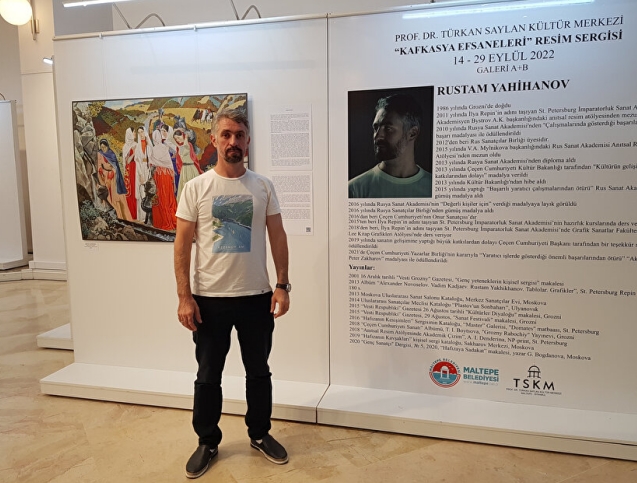While researching Russian illustration artists and their works, I came across the works of Rustam Yakhikhanov. As a Caucasian Muslim painter, both the subjects he dealt with and his painting technique attracted my attention. He made me realise the art of Caucasian Muslims, which I had not noticed before. Yakhikhanov tries to convey many important people and events in Chechen history, especially Sheikh Shamil, to Chechens and other nations through his paintings.
First of all, thank you for accepting my interview offer. Could you briefly introduce yourself? How did your painting journey begin?
I was born in Grozny in 1986. My interest in painting started at an early age; I have had a pencil and eraser in my hand since I was three years old. Of course, at first my parents looked at my scribbles and thought that I was drawing things like other children. Later on, my mother took some of my drawings to an exhibition. When the people who organised the exhibition saw my drawings, they advised me by saying ‘Your child has giftedness, take him to a place with better facilities’. In 2004, I went to the St. Petersburg Imperial Academy of Arts, where I have been teaching since 2018.
Were there any disadvantages for you being a Muslim Chechen student in St. Petersburg?
I was very excited when I went to St. Petersburg, it was a very big city compared to Grozny. At that time the war was going on and the people of St Petersburg were against the war in Chechnya. They had even organised anti-war demonstrations many times. They welcomed me better than I expected. At first I thought they would have a bad attitude towards me.
In our faculty there were Muslim students from Russia and many other parts of the world, from Dagestan to Iran. Differences in culture, nationality and religion never caused any problems between us. At our faculty in St Petersburg, what mattered was one’s ability and morals, identities had no extra meaning.
In your paintings we see the influences of both Soviet painting and Caucasian Muslim culture. How did you create your own style?
Going to St. Petersburg was a turning point for me. Both the education I received at the academy and the atmosphere of St. Petersburg affected me a lot. I added my own culture to all this. I can say that I was especially influenced by the works of KHamid Savkuev.
What are the general characteristics of Caucasian Muslim painting?
Icon culture prevailed in Russia and painting was not as developed as in Europe. At present, we can say that our art is closer to Europe and classical realism. I should add that every nation in the Caucasus has its own understanding of art. Therefore, there is a culturally complex structure. This makes it difficult to make a clear definition.



How are your works received in Russia?
There are many nations in Russia. They look at us the way we look at them. My works are quite interesting to Russians. I have not received any negative feedback.
How did the idea for the Legends of the Caucasus exhibition come about?
Boomzi, a Chechen clothing brand, asked me to create modern lines for textiles and other consumer goods that would reflect both the personal and national character of our heroes. Of course, this was quite a big job for me. Because I was offered something that has always been in me and that I have wanted to do since childhood; popularising our cultural and historical heritage. One of the themes of the exhibition is heroes and the other is Chechen mothers, women and children.
Chechen women and children have experienced great hardships, they have suffered a lot in exile. Throughout history, Chechen women, side by side with their men, attacked the enemy bayonets with their daggers. I tried to convey our unbending will and wisdom in the face of the difficulties we face as a people to people through my paintings. I have been exhibiting my works in Grozny for a long time. We also opened an exhibition in Turkey through Teymur Rzayev.
What kind of projects do you have in the future?
I had exhibitions in Moscow, St. Petersburg and now in Istanbul. After this, I want to continue to organise exhibitions in different places. My Chechen acquaintances residing in Ankara asked me to open an exhibition there. Hopefully, it will be a good transfer of information about our own culture. We have made plans for this, I will soon have an exhibition in Ankara.
In the future, I want to tell about the Chechen-Ingush Exile in the Caucasus. This is my biggest dream. I want to tell about the life of our people who were sent to Kazakhstan in exile and the difficulties they experienced. I am working on this project. I am working on a 250×9000 metre painting specially for this. I want to depict all the peoples who were exiled the Caucasus there.
